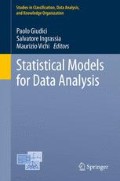Abstract
Due to the complexity and heterogeneity of hedge fund strategies, the evaluation of their performance and risk is a challenging task. Starting from the standard mutual fund industry, the literature has evolved in the direction of refining traditional measures (e.g. the Sharpe Ratio) or introducing new ones. This paper develops an approach, based on the Principal Component Analysis, to uncover the relevant information for performance measurement and combine it into a unique rank.
Access this chapter
Tax calculation will be finalised at checkout
Purchases are for personal use only
Notes
- 1.
MSCI World Index and Barclays Euro Aggregate (BEA) are chosen to represent correlation with Equity and Bond market.
- 2.
It should be pointed out that maximum drawdown is an empirical measure, without any statistical consistency.
- 3.
A different solution can be found in Bramante and Zappa (2011).
- 4.
Kurtosis are translated to zero.
- 5.
These are the two widely recognized hedge fund index providers in the industry.
- 6.
Since the ability of this method in summarizing common patters depends on whether data contain strongly correlated variables, average partial correlation between variables was computed across the three considered years. Above all, the largest ones are between the three “Cornish Fisher” indicators and within the risk variables (Annualized Volatility, Negative Semi Deviation and Value at Risk 5 %).
- 7.
A varimax rotation was performed.
- 8.
Similar results, referred to the remaining two scenarios, are omitted.
- 9.
30 % is arbitrarily chosen. However, empirical simulations show that 30 % of asset allocation in hedge funds seems to be closed to the optimum, in terms of the distance from the efficient frontier.
References
Agarwal, V., & Naik, N. Y. (2004). Risk and portfolio decisions involving hedge funds. Review of Financial Studies, 17(1), 63–98.
Bramante R., & Zappa, D. (2011). Value at risk estimation in a mixture normality framework. In Proceedings of the Eighteenth International Conference Forecasting Financial Markets—Advances for Exchange Rates, Interest Rates and Asset Management, Marseille.
Brealey, R. A., & Kaplanis, E. (2001). Hedge funds and financial stability: An analysis of their factor exposures. International Finance, 4(2), 161–187.
Fung, W., & Hsieh, D. A. (1998). Performance attribution and style analysis: From mutual funds to hedge funds. Working paper, Duke University, Fuqua School of Business.
Fung, W., & Hsieh, D. A. (1999). A primer on hedge funds. Journal of Empirical Finance, 6, 309–331.
Géhin, W. (2004). A survey of the literature on hedge fund performance. Nice: EDHEC Risk and Asset Management Research Centre, EDHEC Business School Lille.
Hill, G. W., & Davis, A. W. (1968). Generalized asymptotic expansions of Cornish–Fisher type. Annals of Mathematical Statistics, 39, 1264–1273.
Ineichen, A. M. (2003). Absolute returns: The risk and opportunities of hedge fund investing. Hoboken: Wiley.
Kahnemann, D., & Tversky, A. (1979). Prospect theory: An analysis of decision under risk. Econometrica, 47(2), 263–292.
Lhabitant, F. S. (2004). Hedge funds, quantitative insights. Chichester: Wiley.
Markowitz, H. (1959). Portfolio selection. Journal of Finance, 17(1), 77–91.
Mitchell, M., & Pulvino, T. (2001). Characteristics of risk in risk arbitrage. Journal of Finance, 56, 2135–2175.
Modigliani, F., & Modigliani, L. (1997). Risk-adjusted performance—how to measure it and why. Journal of Portfolio Management, 23(2), 45–54.
Acknowledgments
The development of this paper benefited significantly from the input and support of Alessandro Cipollini and Antonio Manzini.
Author information
Authors and Affiliations
Corresponding author
Editor information
Editors and Affiliations
Rights and permissions
Copyright information
© 2013 Springer International Publishing Switzerland
About this paper
Cite this paper
Bramante, R. (2013). An Approach to Ranking the Hedge Fund Industry. In: Giudici, P., Ingrassia, S., Vichi, M. (eds) Statistical Models for Data Analysis. Studies in Classification, Data Analysis, and Knowledge Organization. Springer, Heidelberg. https://doi.org/10.1007/978-3-319-00032-9_8
Download citation
DOI: https://doi.org/10.1007/978-3-319-00032-9_8
Published:
Publisher Name: Springer, Heidelberg
Print ISBN: 978-3-319-00031-2
Online ISBN: 978-3-319-00032-9
eBook Packages: Mathematics and StatisticsMathematics and Statistics (R0)

